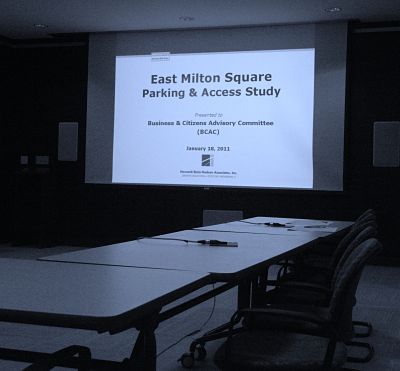Parking problem in East Milton? What parking problem? According to data presented by Keri Pyke of Howard/Stein-Hudson, there is no time of day during which parking is unavailable to people traveling to East Milton Square, though it may not be where they want it.
Ms. Pyke presented data from a Parking Turnover Study her firm conducted that indicated that even during peak periods (10:00AM – 1:00PM on Saturdays) about 10% of overall parking space inventory was available. In other words, 90% of available parking spaces are used. The study was broken down by weekday and week end and by designated spots (ie parking denoted by hash marks on the street) and on street unmarked parking and lots. She noted that some lots have relationships with other businesses and organizations. For example, St. Agatha’s allows Fitness Unlimited patrons to park in their lot though Pike noted few seem to take advantage of that. Parking spots were also categorized by demand. For example, those west of the expressway were considred least desirable while those in vicinty of Adams Street and Granite Avenue area were most highly desirable. Regardless, of the location, time of day, or type of spot, the study indicated that spots were available. Ms. Pyke concluded that the lack of parking “is a perception problem and our data bears that out.”
Why does the perception exist and what can be done? Pyke identified two major issues with parking in the square: lack of a clear traffic circulation and absence of wayfinding. Regarding traffic circulation all one needs consider is how they would circle back to a parking spot they passed on say, Granite Ave or Adams Street. Wayfinding relates to signage and directions to parking locations. Many may not realize that St Agatha’s is available to Fitness Unlimited customers, for example. In addition other factors were identified. For example, people don’t like to walk. The expectation is that they want a spot in direct proximity to the shop, business they are visiting. Pyke said the industry norm for evaluating parking availability was within a quarter mile (5 minute walk) of a business district. Even if one wanted to walk – it’s not easy. East Milton Square has the longest crossings of the towns Howard/Stein studied for comparison purposes. One has to go 61 feet across 3 traffic lanes in some sections. The town squares used as comparisons were Newton Center, Hingham, and Concord).
At least two members were not convinced and had concerns over the data. he questions pertained to how the parking was classified and getting a more thorough understanding of how it was defined and compiled. One board member said the data “is not matching what I’m familiar with. [I’m] not seeing 1- 15% availability – doesn’t feel right.” Pyke noted the concerns and will be annotating the presentation which will be available online shortly (You can find a comprehensive site on the study here.)
The next meeting will be held on February 9th and will include a discussion of existing traffic conditions, concept development and analysis, and local merchant survey results.
